Newsletter
Current
Previous
|
September 2010
|
|
|
|

Rural Earley Beneath Your Feet
Thrush family (cont'd)
Grassroots Funding
Green Fair
Going, going, nearly gone. Hay meadows
Personal recollections part 6 David Smith
Maiden Erlegh School weather forecast
Bug Hunt 2010
EASI update
The Price of Cotton
The Friday Group
Sibly Hall Redevelopment
Green Heroes: Rachel Carson
Plus Regular Items :
News from Beyond Earley
Earley News and Wildlife Sightings
Forthcoming Events
Bits and Pieces
|
The year is whizzing past. Summer gone and autumn here already. Time for harvest. Hay-making would have come and gone. When Jane Taylor, born over a hundred years ago on a Berkshire farm, wrote about it in Memories of Old Berkshire, she laments, "What more lovely sight than three beautiful shire horses on a binder?....Two men, perhaps more, would be sent in a field of clover ready for cutting; starting early in the morning they would keep on as long as they could see. They walked a few yards behind each other, and the rhythmical swing of the scythes and the swish of the falling grass which lay in straight rows all across the field was something worth watching." Earley would have seen such a scene on its many farms, see below. The hay meadows have gone, no more lines of men with scythes, no cart horses, but there are still mini-meadows in Earley - our roadside verges, see here. We need these pockets of wildflowers still to flourish as, insidiously, our wildlife species vanish year by year. Rachel Carson, our Green Hero, knew the importance of maintaining diversity. But we are still learning bitter lessons, as the article on The Price of Cotton shows.
Like the Aral Sea, the green spaces in Earley dwindle almost to nothing. Redhatch Copse, with its ancient woodland history, is now the subject of possible change, including a 90ft mast. Can you imagine? Ancient woodland with a mast that size, plus its footprint, see here. Thankfully, Whiskey, the cantankerous Co-op Dairy cart horse, still provides some lighter moments.
|
|
|
Get to know your Earley
Rural Earley beneath your feet Where your house stands, farmers and their workers once toiled
September is harvest time; with Earley farms it would have been a very busy season. Until modern times, Earley was divided into a number of fields, many created by the Enclosure Act in the 19th century, although others were much older. Some field names were obvious, others were named after individuals. The Ballard Map of 1756 recorded: Pigwash Close, Farther Hill Ground, Hither Hill Ground, Withy Coppice, Little Horse Close, Great Horse Close, Old Man's Ground, Coney Gree, Hewiss Close, and Dean's Pightle (word dating from 1200 meaning a small piece of enclosed land). This may have evolved into Piddle, as in Tinkers Piddle and Home Piddle fields.
The Earley farming community appeared a very close-knit family group. Elm Farm and Copse Farm were on present-day Elm Lane, once called Goddard and Chapman's Farm Road. This was described as '30 feet wide, commencing at the n.w. corner of Early (sic) Upper Wood Common, continuing by the pond head into a lane leading to a homestead and old inclosure of Sir Henry Englefield called the Coneygree, then n.w. in corner of Early Lower Wood Common, into Parkins' Lane leading to Early Heath.' (Parkins' is a mystery as yet). In the 1881 census there were Goddards living at Copse House Farm on Elm Lane - Joseph Goddard, farmer aged 42, 107 acres employing 3 men and 2 boys. Elm Farm was farmed by Robert Goddard, 72, farmer, 200 acres, employing 5 men and 2 boys. It was eventually owned by Reading University, who pulled it down. In 1834 John Chapman, described as a Gentleman of the Liberty of Early, left a will bequeathing considerable sums to relatives.
Shackel's Farm Road, '30 feet wide leading out of the last described road (Maiden Early Road) on Beech Hill to the entrance of Beech Lane and from the end of the said lane in or near its present track into an eastward direction to a farm homestead of Sir Henry Englefield at the eastward corner of Early Lower Wood Common.' This is the dead-end part of Beech Lane. A farm was situated at the end of it as part of the Maiden Erlegh Estate, shown as New Farm in 1881. The old pond is still there. However, a George Shackel, retired farmer, born Earley, aged 76, was living at Lower Earley Farm off Cutbush Lane with family members. Another George Shackel, land agent, aged 45, was living with his family at Earley Court Farm. There is a painting of William Shackel (b.1804) in Reading Museum who lived at Earley Court Farm; the portrait was used on a Huntley & Palmer biscuit tin.
Clarkes Farm Road, 30ft wide, is now the pedestrianised lane leading from Rushey Way southward to Cutbush Lane. It originally led to Lower Earley Farm and the Loddon (a John Goddard had a sister Elizabeth Clarke, so perhaps another farming connection?)
|
|  Continuing Ray's article on the Thrush family Continuing Ray's article on the Thrush family
Now what about those other thrushes I mentioned? The Mistle Thrush is the third resident species, which may sometimes be heard singing from a high perch in poor weather - the original "storm cock" - and seen on open parks and playing fields, where it feeds on invertebrates and insects. It needs large, mature trees for nesting. It is larger and greyer than the Song Thrush. Its staple food in winter includes berries and fruit, which it tends to defend in a feeding territory against all-comers. This strategy may backfire, since the Fieldfare, a bird of similar size, invades in nomadic hordes and can clean the Mistle Thrush's larder in no time at all. 
Fieldfares arrive in autumn with their smaller cousins, the Redwings. Most of them come from Scandinavia. They are more likely to be seen out in the countryside, where their flocks provide safety in numbers and plenty of eyes to find new food, but as we saw all too well in the snowy spell, they come close to houses to systematically strip the berries of such as rowan, pyracantha and cotoneaster. Both are obviously thrushes: the smaller Redwing has a cream-coloured eye-stripe and russet streaking on the flanks; the larger Fieldfare has a slaty head and back, with a golden ground to its speckled breast.
The Ring Ouzel is occasionally seen on passage in Berkshire as it comes up from the south to breed in summer on high moorland. I was lucky enough to see one resting at nearby Whistley Green a few years ago. It is like a Blackbird with a white crescent on its chest - but don't be fooled by the occasional patchy Blackbird: that is just a plumage aberration.
And just to emphasise that nothing is quite neat in the world of these thrushes, the Blackbird or Song Thrush in your neighbourhood in summer may well have returned from further south, and those that spent the winter with you may have gone back north with the winter thrushes. One ringed Blackbird was known to migrate seasonally between Norfolk and the West Country. They all look much the same, so the change in population is barely perceptible.
Birdsong is one of the great free bounties of spring and summer, as the fluting, honeyed, fluent phrases of the Blackbird's song drift lazily over gardens. If we are lucky and are careful in our garden habits, we may still be able to hear the virtuoso Song Thrush, who is so pleased with his song that he sings everything at least twice. So don't forget to cross those slug pellets off the shopping list!
Ray Reedman
|
 |
GOODNEWS FOR BIRDS We are the grateful recipients of a 'Grassroots Grant' of £2500 from the BERKSHIRE COMMUNITY FOUNDATION. This very generous grant will enable us to buy indestructible bird and bat boxes for use in Maiden Erlegh Local Nature Reserve, as well as various other items.
|
 |
|
Annual EARLEY GREEN FAIR 7.8.10
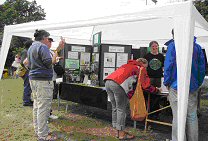 The rains came, but we soldiered on, as did the many other stall-holders. We salute all those who visited in spite of the weather, and they weren't disappointed at the variety of stalls. There was something for everyone - from friends of the Earth's solar-powered spinning disk, moth and butterfly info, news of the restoration of the steamship Medway Queen, vital cups of coffee, to mention just a few. Thank you to all those who browsed the EEG stand, with competitions, free seeds, wild flowers and lots of information (see EEG stand right, manned by Anne). The rains came, but we soldiered on, as did the many other stall-holders. We salute all those who visited in spite of the weather, and they weren't disappointed at the variety of stalls. There was something for everyone - from friends of the Earth's solar-powered spinning disk, moth and butterfly info, news of the restoration of the steamship Medway Queen, vital cups of coffee, to mention just a few. Thank you to all those who browsed the EEG stand, with competitions, free seeds, wild flowers and lots of information (see EEG stand right, manned by Anne).
|
|
|
|

|
They were just fields, but once our country was awash with the colours of the flowers in an English hay meadow. |
Polly Devlin in her book A Year in the Life of an ENGLISH MEADOW writes, "To us, of course, then (in the 1950s) they were just fields...We did not know it, but they were national treasures, an ageless heritage of pastures and swards and meadows. We should have protected them but we took them for granted. When we ran through our meadows there arose from the grasses such a humming and a fluttering as made the eyes and ears dance in trying to accommodate it. You had to watch where you put your feet. Corncrakes, mice, hares, rabbits and birds scuttered and scolded away from you. Butterflies and insects of every kind rose in a cloud."
|
|
DISAPPEARING MEADOWS
In the past 50 years, most of our wildflower meadows have disappeared, to the tune of an astounding 97%. "Constable? Turner? Give me a hay meadow any day," says Tony Bullough of the National Trust. The Trust has been purchasing farms and hay meadows, such as New House Farm, Yorks, through auctions to maintain and protect them where possible.
THEY CAN BE RECREATED
Environmentalists fret at the loss of diversity as old meadows vanish, with all the attendant wild life, but we do have the ability to recreate these meadows, or at least give some space for its associated flowers, perhaps in a corner of the garden. The wildflower meadow created in the Maiden Erlegh Nature Reserve is a visual treat in spring and summer.
OUR ROADSIDE NATURE RESERVES
Earley is an intensely developed area but, if we stop to look, we do have a considerable number of places where wild flowers flourish - our roadside verges. Invaluable pockets of natural growth, insects can sup at the life-saving pollen and nectar and, no, they are not just weeds! One of our plant expert members recorded pyramidal orchids and two fairly uncommon plants on just one short stretch of what looked like a barren strip of dried grass.
MINI-MEADOWS
As part of our contribution to the International Year of Biodiversity, EEG has decided to take a close look at all our roadside grass verges, and eventually gain the co-operation of WBC to design a mowing regime sympathetic to the most worthwhile verges, which is also acceptable to the human residents. It's not impossible. This has been done in several other counties in the UK.
Create your own wildflower meadow: download a booklet from Plantlife
www.pictorialmeadows.co.uk is more for gardeners.
|
|


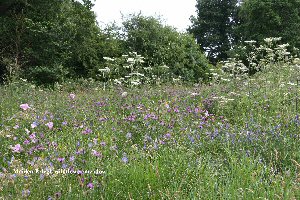

|
|
PERSONAL RECOLLECTIONS
BY EARLEY RESIDENT DAVID SMITH (part 6)
|
|
MEMORIES OF MOVING TO EARLEY TO ESCAPE THE WAR IN LONDON: David as a young child moved to Earley to stay with relatives at 17 Salcombe Drive after the first bombs dropped on London. Before starting his National Service, David finds a job at the Co-op Dairy, Maiden Erlegh. He was assigned a difficult, cantankerous horse, Whiskey, involving David in several hair-raising episodes (cont'd from June issue).
|
|
I did all the driving and Wilf organised the deliveries so that we were doing the round in good time. He was telling me one day that he was so good with horses that if he shouted any instruction then they would obey it. In response to my jeers, he said that if I was to get Whiskey galloping, Wilf, as passenger, would shout "Stop galloping" and Whiskey would immediately slow to a trot. We were at the end of Beechwood Avenue in Woodley which is long and straight and suitable for a spot of chariot racing. This was my chance to be Charlton Heston in "Ben Hur"! I whipped Whiskey into a gallop and soon the lamp posts were whizzing by on each side and people were getting off their bikes. We thundered down Beechwood Avenue, with Wilf bawling, "Stop galloping! Stop galloping! Stop galloping", and Whiskey totally ignoring him.
This turned out to be a case of a little horse sense being a dangerous thing. Cart horses get used to doing a daily round in a particular way. Whiskey's previous roundsman used to turn right off Beechwood Avenue: we were going straight on. Whiskey thought he should turn right, which was intelligent. Turning right at full gallop was not. We veered across the road and Wilf was quick to jump off. The resultant of two forces, that is going straight on and simultaneously turning to the right, is the bisecting angle which, in this case, ran across the pavement and through a fence into the front garden of the house on the corner. As the cart went over the kerb, I was reminded how Hollywood depicted a stagecoach crash with the view of the oncoming scene suddenly on its side, up again and then on its other side. As we went through the six-foot fence into the garden, I came face to face with a man in the bay window of the house drinking a cup of tea. The cup and saucer dropped from his hands. Whiskey, with hooves
|
dug into the front lawn, stopped remarkably quickly. He had the sense to back us out of the private property and then fell down on the pavement, presumably for a breather. Breather over, he attempted to get up by rolling on his sides with hooves flailing. He only succeeded in tying himself up in the harness. Wilf came puffing up. "Sit on his head! It's the only way to stop him getting up. Sit on his head!"
I did as he told me and Whiskey lay still, panting loudly. Wilf set about freeing him from the harness. A big crowd had already gathered and I could hear newcomers arriving and saying, "What's he sitting on his head for?" Whiskey had an inch-long cut on his thigh and had bitten his tongue. Probably the shock put back his recovery from his little problem but he was back on duty with us the next day.
Wilf went to the Co-op store, which was two hundred yards away. He used their phone to report our mishap and to get us some Woodbines. The dairy manager arrived in a car, a vet came to give Whiskey the once- over. A van arrived and I had to transfer the milk and the empties off the cart. As I left the scene in the van with the driver to continue the round, Wilf was about to re-harness Whiskey to walk him back to the stables and the manager was in earnest conversation with the house owner. I never did find out what Wilf put on the insurance claim form, as I was never asked to witness it.

|
|
Get a really local weather report
The Maiden Erlegh School Weather Club meets once a week for half an hour of intrigue and excitement about the Geography in our skies. We collect deep archive data, reaching back to 25th November 2009, recorded every fifteen minutes. Our weather station delivers readings which, for our local area, have proven slightly more accurate than even the Met Office. We have already covered subjects in depth including cloud formation, climate change scepticism, weather fronts, tornadoes, despite a somewhat faulty experiment, and hurricanes which can now be seen on our website's storm-tracker. Other planets have been highlighted and an ex Met Office professional weatherman has shown great interest in our meetings. The effects of the recent Icelandic volcano ash cloud have also been investigated by our team with satellite maps. Make sure that you look at the live data on the Maiden Erlegh homepage and click on the sticker for more detailed information http://www.school-portal.co.uk/GroupHomepage.asp?GroupID=162859 . It is also on the home page of www.earleyenvironmentalgroup.co.uk .
|
|
|
|

Held on 11th August in Maiden Erlegh Nature Reserve, when eleven intrepid young explorers searched out bugs, examined them closely with microscopes etc. and then carefully let them go. They were finally treated to the release of many moths caught in a light trap by Alan, our bug expert, who led the exploration.

Photos by Derek Cashen
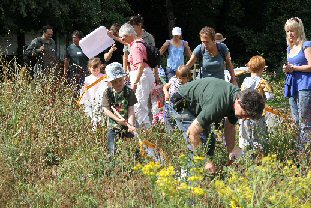
|
|
|
EASI does it!
(Earley Adopt-a-Street Initiative)
A big thank you to all EEG members who have signed up to the Earley Adopt-a-Street Initiative and are now happily (I hope) litter-picking along their road, or somewhere nearby that needs it. With you and others, there are now more than 60 EASI-pickers at work across Earley: I never dreamt that my idea would take off like this! I must also thank Brian Hackett for his administrative hard work (including handing out the equipment), and our councils (for supplying it).
However, there are still plenty of streets not covered by EASI, particularly in N Earley, so if you would like to join in, do please contact Brian on 986 1115. Choose a length of street etc that you feel you can manage to keep reasonably free of litter, and go out when it suits you. And of course anyone can help simply by picking up items and binning them. There's no shame in keeping Earley tidy!
Peter Soul
|
|
|
|
The Price of Cotton: Like wood, cotton is a material provided by nature, though rather than being all around us, it can actually end up on us, right next to our skin in the form of clothes and underwear! After we have used it, cotton ought to return to the cycle of matter.
Although covering 'only' 2.5% of all farmland on the planet, the cultivation of cotton uses a much higher percentage (from 10% to 50%, depending on the source) of all pesticides and insecticides sprayed onto the entire globe. These chemicals persist and are not metabolized in natural processes. Together with the synthetic fertilizers (also massively employed in this business, releasing N2O, a greenhouse gas 300 times more potent than CO2), they thus make cotton one of the dirtiest, if not the most polluting, of crops. See here for more information. |
 The Aral Sea: abandoned fishing boats litter the dry landscape
Photo kind permission of Christopher Herwig |
|
In countries like Burkina Faso, the production of cotton represents the livelihood of entire families for the whole year, while in industrialized countries such production is heavily subsidized (as well as being very inefficient energywise). Sadly, this makes it quite difficult for producers in developing and non-industrialized countries to be competitive.
The effects on the environment are highly detrimental: in Uzbekistan, the second-largest exporter of cotton, production has reduced the Aral Sea (see picture above), once the fourth-largest inland body of water, to a mere 15% of what it was, and has brought 24 species of native fish to the edge of extinction. This is a particularly bad example of the long-time mismanagement that continues to our day, with a price dearly paid by children, adults, and the natural environment.2 However, there are encouraging signs: the production of cleaner and organic cotton is on the increase overall, while the Fair Trade mark helps towards the reduction of injustice. Does it work? Yes. The proof? Try, for example, People Tree for fashionable clothes, with a line endorsed by Emma Watson, or Organic Cotton for big fabrics. Enjoy! Ornella Trevisan
|
|
|

|
In the International Year of Biodiversity, EEG has decided to form a Friday group, meeting on Friday mornings from 9.30 a.m. to 12.30 p.m. at the Interpretation Centre, Instow Road. The aims are:
- to survey and afford protection where necessary to the wildflowers in Earley's roadside verges
- to produce maps and leaflets on cycling and walking in Earley, for recreation and everyday travel to shops, doctors, work etc.
- to continue surveying veteran and notable trees in Earley.
If you can afford a few hours and would like to contribute in some way, contact Grahame Hawker, Earley Town Council, Council Offices, Radstock House,Radstock Lane, Earley, RG6 5UL. 0118 986 8995
|
|
|
Sibly Hall Redevelopment
The University of Reading is proposing to demolish Sibly Hall, build 101 houses, and relocate the mobile phone mast currently mounted on Sibly Hall roof. An Environmental Impact Assessment will be done before a full planning application is put in, probably in the autumn.
Redhatch Copse forms part of the site and, as ancient woodland and a designated Wildlife Heritage Site, is protected from development. The rest of the area is, apart from the Hall and car park, mostly open areas of mown grass, with a stream with hedgerow and trees running down one side. There was a wonderful wild area of bramble, long grass and regenerating trees between the copse and Redhatch Drive, but this has been cleared over the last 2 years by the University. We are concerned at the effect the proposed development would have on the Copse, the stream and quality of water feeding into Maiden Erlegh lake, also the impact of increased traffic on local roads, especially Redhatch Drive, and the damage to the Copse of erecting a 90' mobile phone mast within it.
For more information on the proposals click on WBC Planning and enter SO/2010/1544.
|
|
GREEN HEROES: Rachel Carson 1907-1964, US biologist, writer and ecologist
It's not often one book changes the thinking of millions of people, but Rachel Carson's seminal book 'Silent Spring' published in 1962 did. It exposed the devastating effects of the use of synthetic chemical pesticides. She warned of the results - a silent spring with no birds singing - and the world took notice. In her book, she called for a change in attitudes to the natural world. In spite of being attacked by the big guns of the chemical industry and some in government as an alarmist, she testified before Congress in 1963, and called for new policies to protect human health and the environment. Fortunately she had the support of influential environmentalists who helped her respond to her critics, and several of these supporters were honorary pall-bearers at her funeral at the Washington National Cathedral in April 1964. She tragically suffered an early death at the age of 56 from cancer, two years after the book's publication.
Nearly fifty years later, criticism still surfaces as to the negative effects the book had, and one has to wonder at the source of this criticism. She has been accused of causing millions of deaths through the banning of DDT to fight malaria, but it was never banned for this. The World Health Organisation recommends the use of 12 insecticides, including DDT, in public health use.
Her literary talent made her books accessible to all, and 'Silent Spring' was a wake-up call to people on both sides of the Atlantic about the dangers posed by widespread use of agricultural pesticides. The battle was won, but not the war. A book has just been published, deliberately called 'Silent Summer': it catalogues the environmental dangers still facing us, which have become increasingly complex, but also puts forward solutions. A foreword from Sir David Attenborough hails the book as "a benchmark . . . invaluable and irreplaceable", so the war still goes on. However, Rachel Carson was the courageous and talented individual who made the world consider its possible future, without any birds singing in spring.
www.rachelcarson.org
'Silent Spring' by Rachel Carson, still published as a paperback
'Silent Summer: the state of wildlife in Britain and Ireland', editor Norman Maclean, Emeritus Professor of Genetics at Southampton University, hardback.
|
|
NEWS FROM BEYOND EARLEY
A nightingale travels 3000 miles! The male bird, code-named OAD, left Norfolk on 25th July last year and travelled through France and Spain down the coast of West Africa to Guinea-Bissau, where it spent the winter. It returned to Britain in April. BTO scientists know this because they fitted a tiny device to the bird, which revealed where birds go to in winter. The device weighed just l gramme. It's a gamble on whether they capture the bird on its return, as the geolocator is not big enough to transmit the information directly. The BTO fitted 20 nightingales with geolocators in 2009, and this spring they recaptured seven of them, all in Norfolk. Five devices failed and one only partially worked, but the logger on AOD recorded its journey in full.
Misplaced Government cuts? Information received from John Booth, an EEG member
Green bodies to be axed include the Sustainable Development Commission (SDC), its independent environmental watchdog and advisory body. The Royal Commission on Environmental Pollution (RCEP) also faces the axe. John writes, "The SDC has been providing advice on environmental improvement leading to cost savings worth far more than its budget. The RCEP has been producing reports on transport, nuclear power, biofuels, nanotechnology for many years - the 1976 'Flowers Report' on nuclear power was my introduction to the topic, and 'Energy - the Changing Climate' in 2000 has been invaluable. What will we do without them? Who can we trust?"
http://www.bbc.co.uk/news/science-environment-10725394
http://www.telegraph.co.uk/news/obituaries/7861727/Lord-Flowers.html
Greenfinch Disease: Trichomoniasis , a disease normally associated with pigeons, jumped the species barrier and began to affect finches in 2005. Populations dropped by a third in some parts of England within a year of the emergence of this disease. Chaffinches were also hard hit. The source is a parasite, Trichomonas gallinae, causing disease in pigeons and doves. This may be passed on when they leave parasites on bird baths or bird feeders. Finches seem to be particularly vulnerable. It causes disease at the back of the throat and gullet. Hygiene is essential. People should wash their bird baths and feeders every couple of weeks, or even provide clean water every day. Emptying and drying the birdbath may help as the parasite cannot survive dry conditions. Any signs of disease should be reported to the Garden Bird Health Initiative on 0207 449 6685.
Vanishing house sparrows: Scientists are still baffled by the disappearance of the house sparrow in some areas. No sparrows were visible in Trafalgar Square on 19th August, whereas a few years ago it was full of them. The last pair to nest in St. James' Park, London was in 1998. They are still numerous in New York and Washington. A 」5000 prize for a valid scientific explanation has not yet been awarded. The nearest to claim this was Kate Vincent, whose 2005 PhD thesis showed sparrow chicks in some places were dying of starvation in their nests because of lack of insect food, but the judges were not unanimous.
|
EARLEY NEWS and WILDLIFE SIGHTINGS
Some members are keen and very competent photographers, and many of their photos are available on the EEG website. Here are a few received in recent weeks. Top left, Unwanted spectator by Derek Cashen, top right, Hitching a Ride and bottom left, Corncockle by David Jupe, bottom right Silver Washed Fritillary by Ricki Bull
|

|

|
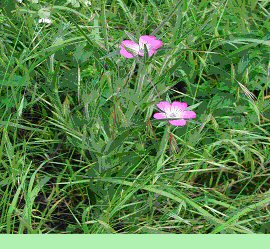
|
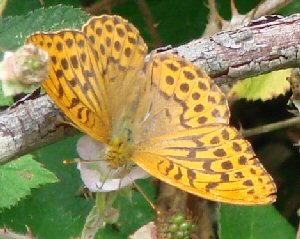
|
|
Our Wildlife Garden Surveys
Insects: as to be expected, they figured largely in the July survey. Both Margaret and Gillian were visited by holly blue (1) and large white (1) butterflies. Margaret also had comma (1), and small white (4), and Gillian red admiral (1), speckled wood (1), gatekeeper (1) and lime moth (1) which she describes as beautiful. Margaret also noted a variety of ladybirds - 7-spot, 2-spot, kidney-spot, harlequin, and pine on runner beans, and 24-spot on dahlias, oakbush cricket, and hoverflies Erisyrphus balteatus, a delicate little hoverfly, and Zanthogramma pedissequum. Also visiting her garden, emperor dragonfly, black garden ant (swarming on white daisies), pollen beetle and greenbottle.
Birds, more notable entries: June blessed Margaret's garden with a group of 8 longtailed tits, a coal tit with three young, and a blackcap, and in July there were ten longtailed tits, one coal tit and one pied flycatcher. Gillian noted swifts and a gt. spotted woodpecker in both months, and a green woodpecker on the back lawn in July.
|
|
LOCAL FORTHCOMING EVENTS
|
September: | Wednesday, 15th "British Bats and Bats of the World", 7.30 p.m. talk by Julian Mason, Function Room, Maiden Place Community Centre, off Kilnsea Drive.
| |
October: | Monday, 18th "Spiders", talk by Martin Woolner, Function Room, Maiden Place Community Centre, off Kilnsea Drive.
| |
November: | Wednesday, 17th "Towards a Sustainable Earley: the Cold Ash experience of the Greening Campaign", 7.30 p.m. a talk by Robert Pattison, Function Room, Maiden Place Community Centre, off Kilnsea Drive.
| |
December: | Monday, 13th EEG Christmas Social 7.30 to 10 p.m. Pop in at any time to meet committee members. There will be seasonal refreshments, and music and songs to entertain. Interpretation Centre, Maiden Erlegh Nature Reserve
|
|
For EEG and other outside events, check the EEG website calendar under Events.
On October 23rd, there will be a second showing of the film "In Transition" at RISC, 35-39 London Street, Reading RG1 4PS. 0118 958 3555, details to be confirmed
|
|
|
BITS AND PIECES
|
|
Loddon Bridge's claim to fame: Ray, one of our members, has sent more information on Loddon Bridge (see issue 20 June 2010). Before the famous meeting at Runnymede in 1215, King John met a representative number of barons at Loddon Bridge, then on the outskirts of Windsor Great Park. The dispute was unresolved, and an undignified race ensued between the King and the barons to reach the Treasury in the Tower first, which the King had left poorly guarded. John and his retinue managed to get back to London first so he was able to hold out a little longer before capitulating to the Barons' demands. This evidenced that there was a Loddon Bridge 800 years ago (source: book on History of Berkshire in Reading Central Library).
"Create Your Own Wildflower Meadow". If you don't have a computer and would like a hard copy of the booklet, write to 2 Reeds Avenue, Earley RG6 5SR for a copy.
A bit of time to spare? Can you offer active help to the Group? If you can, phone 0118 962 0004 or go to the website. We would welcome more member involvement. If you have no expertise and would like to get involved, you may be able to give practical help. Perhaps help with distributing the newsletter hard copies, or maybe you have graphic design skills (for occasional posters, leaflets), computer skills, any other skills to offer. Do your bit for the environment.
Join the EEG Yahoo Group and post your sightings and messages. You’ll find a link to Yahoo on our website.
EEG Committee Members can be found on www.earleyenvironmentalgroup.co.uk under Contacts, or phone 0118 962 0004
For Wildlife Survey Forms, go to the website or phone Earley Town Council 0118 986 8995
If you know anyone who would like to join EEG, membership forms are available from Earley Town Council, 0118 986 8995, on the website under Downloads , or send an e-mail to liz@helva.plus.com . Please inform Liz if you intend to change e-mail or address at 50 Kenton Rd, Earley RG6 7LG, or send her an e-mail.
|
SUPPORT YOUR LOCAL SHOPS
The True Food Co-op, Silverdale Centre :There is now a True Food Co-op operating in Earley, their most successful market. Their mission is to take low cost organic food out to the people, bypassing the supermarkets which charge a lot for organics They hold markets at the Silverdale Centre on Fridays, 5 to 8. 15 pm. They have a website giving dates www.truefood.coop
Pet Fayre 9 Maiden Lane Centre Lower Earley : A small independent shop, with bird feeders of all kinds, a variety of bird feed, large bags of which the shop is willing to deliver locally, or pick it up in your car from the back of the shop, tel 0118 9266512, e-mail sales@petfayre-reading.co.uk or go on the comprehensive website www.petfayre-reading.co.uk
|
|
Thanks to ORACLE Corporation for reproducing our newsletter on recycled paper. Oracle is the world's second largest software company, situated at Thames Valley Business Park in Earley. Oracle UK adheres to the ISO14001 Environment Standard which confirms Oracle has considered and acted upon its environmental impact. As part of Oracle’s corporate social responsibility they support a number of local groups, including us. They have given us valuable support in reproducing the hard copies of our newsletter in colour, as well as printing off posters and membership leaflets for us to distribute to libraries, schools etc. |
|